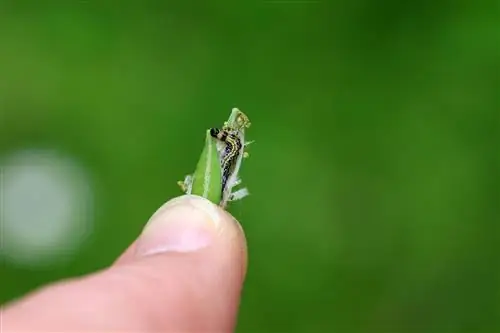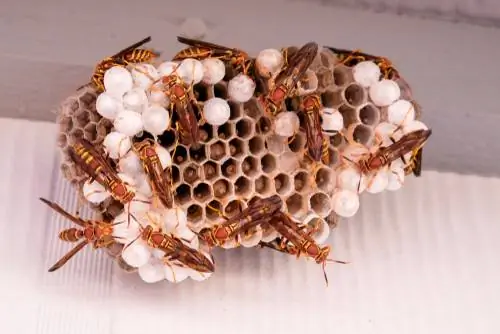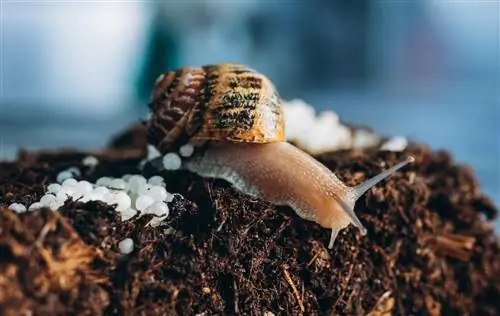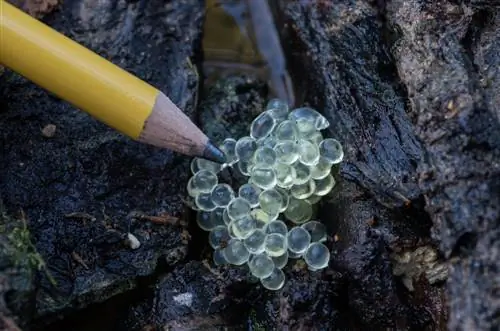- Author admin [email protected].
- Public 2023-12-16 16:46.
- Last modified 2025-06-01 06:02.
The blackbird is one of the most common songbirds in German gardens and parks. However, the pretty bird with black plumage and yellow beak doesn't have it easy: its clutches are often plundered. You can find out in this article whether and how you (should) hatch blackbird eggs you find.

Should you hatch blackbird eggs yourself?
Blackbird eggs should only be hatched by humans in an emergency. If you find abandoned blackbird eggs, observe the nest first to make sure it is truly abandoned. Hatching is difficult and requires an incubator to increase the chances of success.
Profile - Everything about the blackbird at a glance
- Scientific name: Turdus merula
- Other names: Black Thrush
- Genus: True Thrushes (Turdus)
- Appearance: Male - black plumage, yellow beaks / Female - brown plumage with lighter chest, light brown beaks
- Size: between 24 and 27 centimeters long, average wingspan 36 centimeters, weight around 100 grams
- Occurrence and distribution: widespread in Europe, Asia, parts of North Africa as well as Australia and New Zealand (naturalized here)
- Habitat: Cultural followers, primarily in parks, gardens and forests
- Migratory behavior: migratory birds in Northern Europe, otherwise resident birds
- Food: Omnivores, primarily soft food such as berries, fruits, earthworms, arachnids, millipedes, snails, insects in various stages of development, occasionally also lizards, amphibians and shrews
- Endangered status: not endangered
Reproduction and breeding behavior
In this admittedly rather long video you can see how blackbirds breed and raise their young on a balcony:

When do blackbirds breed?
Blackbirds start breeding very early in the year: the females lay their first eggs from the end of February to the beginning of March. In mild winters, the birds also attempt to breed, but these are rarely successful. The animals breed on average two to three times per year, with the last clutch occurring at the end of August.
Where do blackbirds breed?
The birds like to nest in hedges or in house walls or walls covered with climbing plants, as well as in trees and bushes. Nests are rarely found on the ground. The bowl-shaped nest is built solely by the female and consists primarily of plant material such as blades of grass, thin twigs, moss and leaves.
What do blackbird eggs look like?
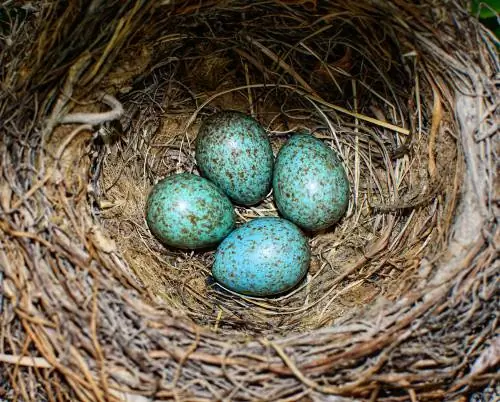
The relatively large blackbird eggs have a beautiful, turquoise-blue color
The usually four to six eggs are laid within 24 hours and are typically green to blue-green and shiny. With a size of around 29 x 21 millimeters and an average weight of seven grams, blackbird eggs are also quite large compared to the clutches of other songbirds. As a rule, the female breeds alone and rarely leaves the nest, for example to feed.
Hatting blackbird eggs and raising chicks
Before you start incubating the blackbird eggs, you should first check that they are fertilized. Chicks only hatch from fertilized eggs, which is why you can save yourself the trouble with unfertilized eggs. Candling the egg with a special candling lamp or other strong light source.
These characteristics distinguish between fertilized and unfertilized eggs:
- unfertilized: clear, translucent
- fertilized: Eggs appear opaque, in later incubation stages blood vessels run through the egg
How to hatch blackbird eggs?
Incubating the bird's egg is the most difficult part of raising blackbirds and is fraught with numerous problems. It is best to place the blackbird eggs in an incubator that maintains the necessary temperature of 38 degrees Celsius and a humidity of 55 percent and turns the eggs regularly.
Many chicken farmers have such a device. If necessary, ask your local pedigree poultry breeding association or the nearest wild bird rescue center. Without such an incubator, the project is hopeless, even if you could theoretically give the blackbird eggs another bird. However, do not try this with a wild bird, as it is also likely to leave its own nest after such an action. Maybe you or a neighbor has pigeons, and eggs like this can be easily foisted on them.
Caring for young birds
Newly hatched young birds primarily need warmth and must be kept constantly warm at 38 degrees Celsius. Place the nestlings in a soft nest made of fabric, paper towels, or similar materials. A red light lamp helps maintain the required temperature. As they get older and their feathers grow, young blackbirds need less and less warmth. Keep the nest clean by regularly removing the poop bags (which are immediately eaten by the parents!).
What do young blackbirds eat?
Do not under any circumstances feed the young blackbirds with minced meat, quark, oatmeal or similar foods. Nestlings are initially provided by their parents primarily with animal food, so they feed the little ones every half hour with, for example, flies, crushed earthworms or mealworms, small beetles and similar creatures. You can administer water with a pipette (for example from a nose drop bottle). Only after about ten to 14 days do the young begin to eat berries and other chopped fruit. You can use a disposable syringe (without a needle) or tweezers for feeding.
Background
Why does the embryo in the egg or the chick die?
There are many reasons why an embryo or young bird dies. These are not always within your control:
- Infection with bacteria, viruses or fungi (e.g. due to polluted environment)
- temperatures too high or too low
- strong temperature fluctuations
- humidity too low or too high, egg dries out
- Misposition in the egg so that the chick cannot hatch
- Egg shell is damaged, egg dries out
Blackbird eggs found - Should you hatch blackbird eggs yourself?

Chicks from found eggs often do not hatch
Before you take care of a seemingly abandoned nest, first observe it for at least two hours: the parent bird is often looking for food and therefore leaves the clutch or its young alone. Even young birds sitting on the ground are rarely abandoned, but continue to be cared for by their parents. However, if your suspicions are confirmed, think carefully about hatching the blackbird eggs: a lot can go wrong and the probability that the embryos or chicks will not survive this attempt is high.
This speaks against hatching blackbird eggs:
- Lack of communication: The blackbird chick communicates with its mother while still in the egg and thus learns its first behavioral patterns typical of its species. These are missing in artificially incubated eggs, so that these animals often do not behave in a typical blackbird manner.
- Sources of error: Incubating blackbird eggs is complicated and often ends with deformities and/or early death of the embryos or young birds. The smallest mistakes have fatal consequences.
- Professional rearing: The young bird must be fed properly right from the start and, above all, cared for around the clock. This also includes letting the animals fledge and giving them their freedom again.
Tip
If you decide to hatch the abandoned clutch, do not touch the eggs with your bare hands. Otherwise, the fine breathing holes in the shell become blocked and the embryos suffocate.
How long can blackbird eggs survive without warmth?
It is impossible to say exactly how long unincubated blackbird eggs can survive without heat. As long as the female has not yet started brooding, she will leave the eggs that have already been laid for several hours or even days. After the third day of incubation, however, it usually only leaves the clutch for around half an hour, or at most up to two hours. If the blackbird egg cools down from this point on, the embryo inside will most likely die.
Excursus
Which species of thrush are still found in Germany?
There are around 80 different species within the genus of true thrushes worldwide. Four of them are relatively common in Germany, another breeds in northern Europe and winters in central to southern Europe. The blackbird can be easily distinguished from the other species by its dark coloring.
“Tweet your song, blackbird, and drive away sorrow and sorrow.” (Khalil Gibran, Lebanese-American poet and painter)

| Art | Latin name | Appearance | Occurrences | habitat | Clutch |
|---|---|---|---|---|---|
| Song Thrush | Turdus philomelos | smaller and more delicate than a blackbird, light brown plumage, spotted on the belly | Europe | in forests, especially coniferous forests | several sky blue eggs |
| Mistle Thrush | Turdus viscivorus | largest native thrush species, similar in color to the song thrush | Europe and North Africa | mainly forests and parks | 4 to 6 light, brown spotted eggs |
| Fieldfare | Turdus pilaris | similar in size to blackbird, strikingly colorful plumage | Europe | Forest edges, orchards, larger gardens, parks | 5 to 6 light green, brown spotted eggs |
| Redwing | Turdus iliacus | smallest species of thrush, similar in color to song thrushes, but with a white belly | Breeding areas mainly in Northern Europe and Scotland, overwinter in Central Europe | Coniferous and birch forests, parks, open woodlands | 4 to 5 light greenish-blue, brown marbled eggs |
Excursus
Which bird egg is this? The most common garden birds and their clutches
Many songbirds nest in a naturally maintained and planted garden. In the following overview we have summarized the most common species and their characteristics so that you can more easily distinguish between the animals and their clutches

The robin's eggs are slightly reddish
| Art | Latin name | Features | Clutch | Nisting Cake |
|---|---|---|---|---|
| Blue Tit | Parus caeruleus | Upside light blue, underside yellow, white cheek spot | 7 to 13, very small, white and slightly spotted eggs | often in nesting boxes |
| Chaffinch | Fringilla coelebs | striking coloring: chestnut brown with blue top of head and neck, black and white wing feathers | 4 to 6 mostly light brown or white, spotted eggs | Bowl nest in bushes or forked branches |
| Great Spotted Woodpecker | Dendrocopos major | large, strikingly colored bird | 4 to 7 white eggs | Cave Breeders |
| Field Sparrow | Passer montanus | dark brown headstock, white cheeks with dark spots; both sexes are colored the same | 4 to 6 white to pale gray, gray to dark brown spotted eggs | Cave Breeders |
| Garden Warbler | Sylvia borin | plain gray with light underside | 4 to 5 white, brown spotted eggs | in bushes, undergrowth and hedges |
| Redstart | Phoenicurus phoenicurus | Male rusty red underparts, gray upper side; Female grey-brown above, yellow-brown below | 5 to 7 light blue eggs | Tree niches, rock and wall holes |
| Goldhammer | Emberiza citrinella | striking lemon yellow with brown striped top | 3 to 5 mostly white eggs with gray to black scribble lines | near the ground in bushes, on the edges of forests |
| Greenling / Greenfinch | Chloris chloris | Male olive green; Female grey-green | 5 to 6 white, dark brown spotted eggs | well hidden in bushes |
| Black Redstart | Phoenicurus ochruros | Male sooty black with white wing patches and rusty red rump and tail; Female grey-brown with rusty red tail and rump | 4 to 6 pure white eggs weighing approx. 2 grams | Tree niches, rock and wall holes |
| House Sparrow | Passer domesticus | Male brown upperparts and wings, gray headplate, black throat, white cheeks; Female grey-brown | 4 to 6 white eggs with gray to brown spots | Wall holes, columns, building niches |
| Dunnock | Prunella modularis | dark brown upperside, gray head and neck area | 3 to 6 green-blue eggs | well hidden near the ground, v. a. in thickets |
| Great Tit | Parus major | largest species of tit with black head and white cheeks, greenish back, yellow underside | 6 to 12 white, reddish-brown spotted eggs, about the size of a dime | in tree hollows or nesting boxes |
| Blackcap | Sylvia atricapilla | grey-brown plumage, black headplate in male, reddish-brown in female | approx. 5 brown spotted eggs | near the ground in bushes |
| Robin | Erithacus rubecula | red front chest and face, olive brown back | 5 to 7 reddish-brown, often spotted eggs, matt shiny | Root niches, wall holes, ground depressions |
| Wren | Troglodytes troglodytes | very small bird with dark brown feathers banded on the sides | 5 to 8 very small, matt white eggs with rusty red dots | spherical, hidden near the ground |
How are the boys developing?
The female blackbird incubates the clutch of eggs between ten and 19 days, with all young hatching within two days. Both parents participate in feeding, with blackbird young consuming around 16 grams of primarily animal food per day. The nestlings leave the nest after about two weeks, but are then almost unable to fly and continue to be fed by their parents. The young birds fly from around the 18th day after hatching and are independent after another two to ten days.
Yay, two blackbird babies have already hatched! On my morning garden tour I found empty eggshells in the vegetable garden and was immediately afraid that the mouse weasel (which is also native to our garden) had been successful. So I immediately went to the nest and was lucky because Amseline was also on tour. We are completely inspired! ??
A post shared by A garden in the north. (@nordgarten) on Jun 30, 2019 at 1:45am PDT
Blackbird eggs suddenly gone - Who steals blackbird eggs from the nest?
Blackbirds breed so often because their breeding is rarely successful due to numerous predators. The clutches are often threatened by:
- free-roaming domestic cats
- Corvids (especially magpies and crows)
- Squirrel
The parents also often fall victim to a predator or traffic, which is why the clutch or the young animals are left without care. Furthermore, the parent birds leave a nest when they become massive while breeding.
Frequently asked questions
Can you eat blackbird eggs?
Theoretically, you can eat blackbird eggs as long as they are freshly laid and not yet fertilized. However, this is nest robbing, and the eggs are often contaminated with salmonella and other pathogens.
Can blackbirds become tame?
Blackbirds are wild birds and usually do not become tame even if they are hand-raised. As soon as the young birds fledge, they leave their “nest” and fly away. Of course, exceptions prove the rule.
How old can blackbirds live?
In human care, blackbirds can live up to 20 years, but in the wild they rarely live longer than three to four years. Most of the time, inexperienced young animals up to the age of one year die, for example by falling victim to a predator.
Tip
Abandoned young birds are best placed in a wild bird sanctuary for rearing. There they are raised professionally and therefore have a higher chance of survival.


